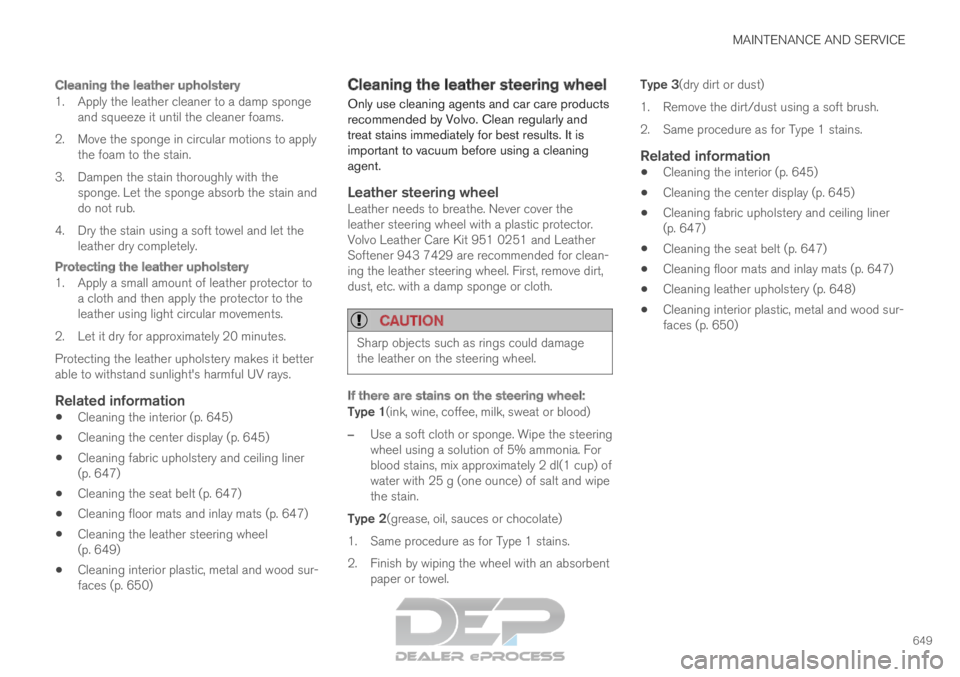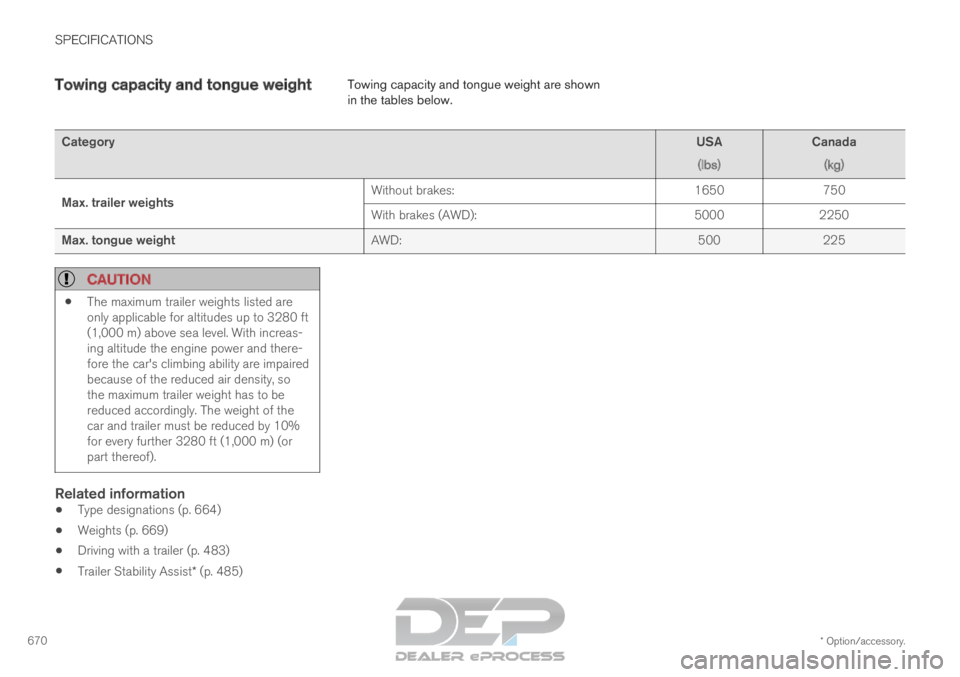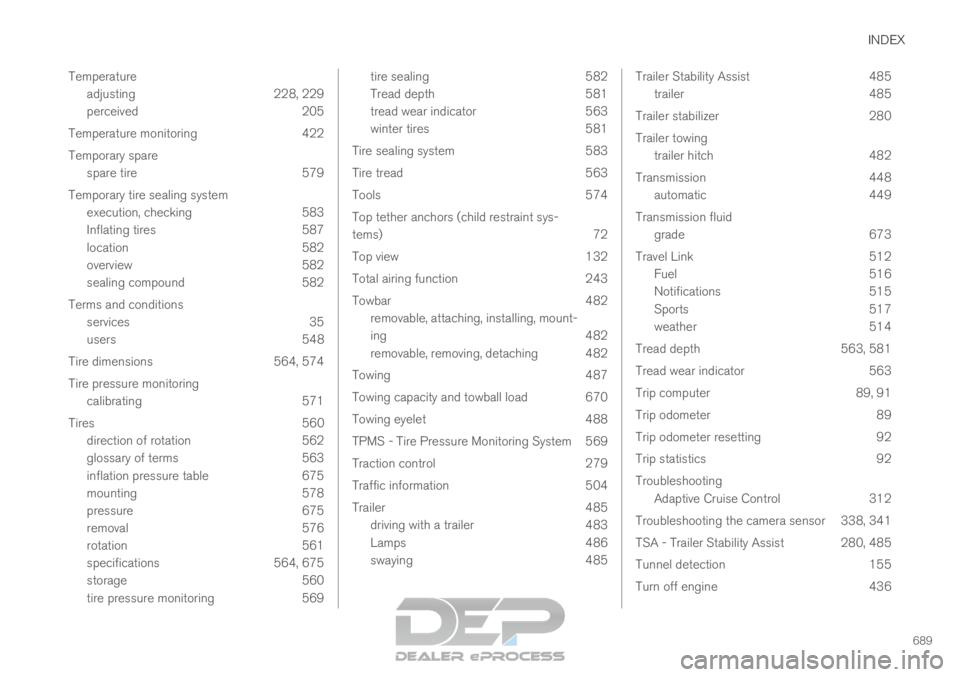tow VOLVO XC90 TWIN ENGINE 2019 Repair Manual
[x] Cancel search | Manufacturer: VOLVO, Model Year: 2019, Model line: XC90 TWIN ENGINE, Model: VOLVO XC90 TWIN ENGINE 2019Pages: 697, PDF Size: 10.33 MB
Page 648 of 697

||MAINTENANCE AND SERVICE
* Option/accessory.
646
CAUTION The microfiber cloth must be free of sand and
dirt when cleaning the center display.
CAUTION
When cleaning the center display, apply only
light pressure to the screen. Pressing too
hard could damage the screen.
CAUTION
Do not spray liquid or corrosive chemicals
directly onto the center display. Do not use
window cleaners, cleaning agents, aerosol
sprays, solvents, alcohol, ammonia or deter-
gents that contain abrasives.
Never use abrasive cloths, paper towels or tis-
sue paper, as these may scratch the center
display.
Related information
Cleaning the interior (p. 645)
Cleaning fabric upholstery and ceiling liner
(p. 647)
Cleaning the seat belt (p. 647)
Cleaning floor mats and inlay mats (p. 647)
Cleaning leather upholstery (p. 648)
Cleaning the leather steering wheel
(p. 649)
Cleaning interior plastic, metal and wood sur-
faces (p. 650) Cleaning the head-up display*
Carefully wipe the glass covering the head-up
display unit with a clean and dry microfiber cloth.
If necessary, the cloth may be slightly moistened.
Never use strong stain removers. For difficult
cleaning conditions, a special cleaning agent can
be purchased at a Volvo retailer.
Related information
Activating and deactivating the head-up dis-
play* (p. 143)
Head-up display* (p. 142)
Page 651 of 697

MAINTENANCE AND SERVICE
649
Cleaning the leather upholstery
1. Apply the leather cleaner to a damp spongeand squeeze it until the cleaner foams.
2. Move the sponge in circular motions to apply the foam to the stain.
3. Dampen the stain thoroughly with the sponge. Let the sponge absorb the stain and
do not rub.
4. Dry the stain using a soft towel and let the leather dry completely.
Protecting the leather upholstery
1. Apply a small amount of leather protector toa cloth and then apply the protector to the
leather using light circular movements.
2. Let it dry for approximately 20 minutes.
Protecting the leather upholstery makes it better
able to withstand sunlight's harmful UV rays.
Related information
Cleaning the interior (p. 645)
Cleaning the center display (p. 645)
Cleaning fabric upholstery and ceiling liner
(p. 647)
Cleaning the seat belt (p. 647)
Cleaning floor mats and inlay mats (p. 647)
Cleaning the leather steering wheel
(p. 649)
Cleaning interior plastic, metal and wood sur-
faces (p. 650) Cleaning the leather steering wheel
Only use cleaning agents and car care products
recommended by Volvo. Clean regularly and
treat stains immediately for best results. It is
important to vacuum before using a cleaning
agent.
Leather steering wheelLeather needs to breathe. Never cover the
leather steering wheel with a plastic protector.
Volvo Leather Care Kit 951 0251 and Leather
Softener 943 7429 are recommended for clean-
ing the leather steering wheel. First, remove dirt,
dust, etc. with a damp sponge or cloth.
CAUTION Sharp objects such as rings could damage
the leather on the steering wheel.
If there are stains on the steering wheel:
Type 1(ink, wine, coffee, milk, sweat or blood)
–
Use a soft cloth or sponge. Wipe the steering
wheel using a solution of 5% ammonia. For
blood stains, mix approximately 2 dl(1 cup) of
water with 25 g (one ounce) of salt and wipe
the stain.
Type 2(grease, oil, sauces or chocolate)
1.
Same procedure as for Type 1 stains.
2. Finish by wiping the wheel with an absorbent paper or towel. Type 3(dry dirt or dust)
1. Remove the dirt/dust using a soft brush.
2. Same procedure as for Type 1 stains.
Related information
Cleaning the interior (p. 645)
Cleaning the center display (p. 645)
Cleaning fabric upholstery and ceiling liner
(p. 647)
Cleaning the seat belt (p. 647)
Cleaning floor mats and inlay mats (p. 647)
Cleaning leather upholstery (p. 648)
Cleaning interior plastic, metal and wood sur-
faces (p. 650)
Page 661 of 697

MAINTENANCE AND SERVICE
659
Changing rear window wipers
The wiper blades help remove water from the
windshield and rear window. Along with the
washer fluid, they clean the glass and help
improve visibility while driving. The windshield
and rear window wiper blades can be replaced.
Changing rear window wipers Lift the wiper arm from the window and pull the lower
section of the blade to the right.
Grasp the center of the wiper blade and lift it
from the window to the stop position.
NOTE
When the wiper arm is halfway folded out, it
will stop in a locking position that helps pre-
vent the arm from falling back onto the rear
window. The wiper arm must be pulled past
the locking position stop in order to change
the wiper blade.
Grip the lower part of the blade and pull to
the right until the blade loosens from the
arm.3.
Press the new wiper blade until it clicks into
place. Check to make sure the blade is
securely in place.
4. Fold the wiper arm back toward the window.
CAUTION Check the blades regularly. Neglected main-
tenance shortens the life of the blades.
Related information
Using the rain sensor (p. 177)
Using the windshield and headlight washers
(p. 179)
Using automatic rear window wiping when
backing up (p. 181)
Using the rain sensor's memory function
(p. 178)
Using the rear window wiper/washer
(p. 180)
Filling washer fluid (p. 662)
Windshield wipers in the service position
(p. 661)
Replacing windshield wiper blades (p. 660)
Using the windshield wipers (p. 176)
Wiper blades and washer fluid (p. 176)
Page 671 of 697

SPECIFICATIONS
669
Weights
The following table lists important weight data
for your vehicle.
Category
USA
(lbs) Canada
(kg)
Gross vehicle weight 7-seat
6635 3010
4-seat 6140 2785
Capacity weight 7-seat
1210 550
4-seat 1000 450
Permissible axle weights, front 7-seat
3130 1420
4-seat 2975 1350
Permissible axle weights, rear 7-seat
3590 1630
4-seat 3305 1500
Curb weight 7-seat
4370–5200 2040–2370
4-seat 5230–5240 2370–2380
Max. roof load 220
100
CAUTION
When loading the vehicle, the maximum
gross vehicle weight and permissible axle
weights may not be exceeded.Related information
Type designations (p. 664)
Towing capacity and tongue weight
(p. 670)
Page 672 of 697

SPECIFICATIONS
* Option/accessory.
670 Towing capacity and tongue weight
Towing capacity and tongue weight are shown
in the tables below.Category
USA
(lbs) Canada
(kg)
Max. trailer weights Without brakes:
1650
750
With brakes (AWD): 50002250
Max. tongue weight AWD:
500225
CAUTION
The maximum trailer weights listed are
only applicable for altitudes up to 3280 ft
(1,000 m) above sea level. With increas-
ing altitude the engine power and there-
fore the car's climbing ability are impaired
because of the reduced air density, so
the maximum trailer weight has to be
reduced accordingly. The weight of the
car and trailer must be reduced by 10%
for every further 3280 ft (1,000 m) (or
part thereof).
Related information
Type designations (p. 664)
Weights (p. 669)
Driving with a trailer (p. 483)
Trailer Stability Assist* (p. 485)
Page 682 of 697

INDEX
680Cooling system
overheating 479
Corner Traction Control 279
Corrosion protection 656
Covering cargo compartment 602
Crash, see Collision 42
Crash event data 33
Cross Traffic Alert – CTA 360, 361, 362, 363
Cruise control 291, 292 manage speed 292, 293
temporary deactivation 294, 295
turn off 296
CTA – Cross Traffic Alert 360, 361, 362, 363
Curb weight 669
Customer Privacy Policy 35
CZIP (Clean Zone Interior Package) 208
D Data
recording
33
transferring between vehicle and work-
shop 612
Data sharing 548
Daytime running lights 154 Decals
location
664
Defrosting 222
Detection of cyclist 345
Dimensions 667
Dipstick, electronic 624
Direction of rotation 562
Display driver information 84
Display lighting 164
Distance Alert 296, 297, 298
limitations 299
DivX ®
523
Door mirrors 169, 171
compass 493
dimming 170
outer 169, 171
power folding 171
resetting 171
store position 186, 187
Driveline transmission 448
Drive mode 454
changing 459
Driver Alert Control 370
operation 371, 372
Driver Alert Control limitations 372 Driver performance
92, 93
Driver profile 136
edit 137, 138, 139
select 137
Driver support system 278
Drive systems 453
Driving cooling system 479
with a trailer 483
Driving economy 467
Driving through standing water 473
driving with a trailer towball load 670
towing capacity 670
E Economical driving
467
Electrical outlet
594
use 596
Electrical system 627
Electric drive motor specifications 671
electric motor 453 Driving 469
Range 469
Page 691 of 697

INDEX
689
Temperature
adjusting 228, 229
perceived 205
Temperature monitoring 422
Temporary spare spare tire 579
Temporary tire sealing system execution, checking 583
Inflating tires 587
location 582
overview 582
sealing compound 582
Terms and conditions services 35
users 548
Tire dimensions 564, 574
Tire pressure monitoring calibrating 571
Tires 560 direction of rotation 562
glossary of terms 563
inflation pressure table 675
mounting 578
pressure 675
removal 576
rotation 561
specifications 564, 675
storage 560
tire pressure monitoring 569 tire sealing
582
Tread depth
581
tread wear indicator 563
winter tires 581
Tire sealing system 583
Tire tread 563
Tools 574
Top tether anchors (child restraint sys-
tems) 72
Top view 132
Total airing function 243
Towbar 482 removable, attaching, installing, mount-
ing 482
removable, removing, detaching 482
Towing 487
Towing capacity and towball load 670
Towing eyelet 488
TPMS - Tire Pressure Monitoring System 569
Traction control 279
Traffic information 504
Trailer 485 driving with a trailer 483
Lamps 486
swaying 485 Trailer Stability Assist
485
trailer 485
Trailer stabilizer 280
Trailer towing trailer hitch 482
Transmission 448 automatic 449
Transmission fluid grade 673
Travel Link 512 Fuel 516
Notifications 515
Sports 517
weather 514
Tread depth 563, 581
Tread wear indicator 563
Trip computer 89, 91
Trip odometer 89
Trip odometer resetting 92
Trip statistics 92
Troubleshooting Adaptive Cruise Control 312
Troubleshooting the camera sensor 338, 341
TSA - Trailer Stability Assist 280, 485
Tunnel detection 155
Turn off engine 436